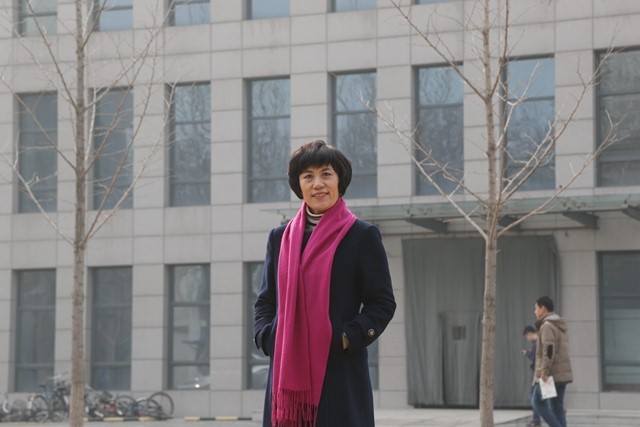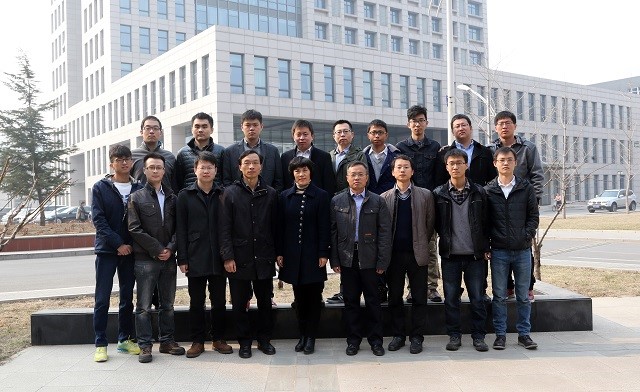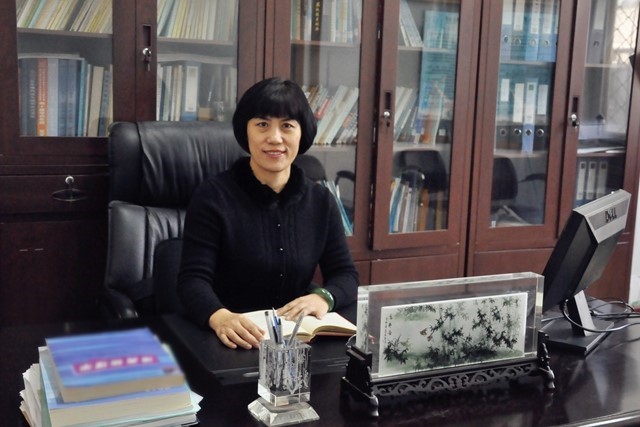At the beginning of 2015, the State Science and Technology Awards, the highest honor to scientists in China, was held in the Great Hall of the People in Beijing. Among the recipients was a woman named Jiang Chunlan, Professor of the School of Mechatronical Engineering of Beijing Institute of Technology, and expert in weapon development and research. She was the leading researcher in the project entitled ※Series Connection Anti-Hard-Target System Technology§, which won second prize in the State Technological Invention Award in 2015.
Keys to Success: Passion and Persistence
Weapons, ammunition and explosives 每 those have long been deemed exclusive to men, since the conventional wisdom is ※war keeps women away§. Ms. Jiang, however, has proved it wrong with her own experience. Enrolled at BIT in 1979 to major in missile warhead development, she has been studying munitions for 36 years. Never did she aired her regrets about choosing the so-called ※unpopular major§ or entering the dangerous industry. Ms. Jiang always expresses her proudness when she talks enthusiastically about munitions. Having worked for years in the industry, she comes to realize, ※as a broadly applicable and interdisciplinary field, ammunition science requires not only mastery of mathematics and mechanics, vast knowledge reservoir, and considerable engineering experience, but also a vision of the evolution of weapon system and the development of the industry. It*s a subject worth spending a lifetime to study.§ Her actions speak louder than her words.

In 1983, Jiang Chunlan was enrolled at BIT as graduate student. Her mentors were Professor Ding Jing, well-known expert in explosion mechanics and detonation physics, and Professor Xu Gengguang, one of the first members of the Chinese Academy of Engineering. She was given instructions by the two learned and established scientists on all aspects of her research, from setting goals and devising approaches to studying theories and conducting practical experiments. Influenced by her professors* dedication to and sense of responsibility for science, as well as BIT*s favorable environment for defense research and the general learning style of the university 每 ※Being realistic, not self-righteous§, Ms. Jiang made up her mind to devote herself to the dangerous and demanding industry.
In 1986, Ms. Jiang was employed by the university to teach and undertake research in explosion science. In 1993, BIT made an exception to confer the title of ※Associate Professor§ on her. At the age of 35, Ms. Jiang was made the leading researcher of her scientific program in 1998; meanwhile, she was working on her Doctor*s Degree. Over the years, she has taken a variety of provincial/ministerial-level scientific awards and been granted over 20 patents for national defense. She is the author of dozens of papers published in Chinese or foreign journals and recipient of many honorary titles. In 2000, Ms. Jiang, at the mere age of 38, was made professor, standing out among her peer educators.
Influenced and encouraged by senior educators in munition science, Jiang Chunlan developed close contact with the army, military enterprises and research institutes, so as to put her knowledge into practice by working in factories. In extremely harsh working environments 每 remote mountain areas, noisy workshops, and experimental bases located in waste lands 每 she contributed to the development of Chinese military industry. During the time, Ms. Jiang through all her work gained invaluable knowledge of and experience in manufacturing approaches, production process, assembly, and field tests of ammunition products. Knowledgeable, experienced, meticulous, determined and responsible 每 with all of these traits, she gradually built up her reputation in the industry.
Solution to Difficulties in Research: University-Enterprise Cooperation
The award-winning ※Series Connection Anti-Hard-Target System Technology§ program is an innovative research in ammunition for major equipment of a new generation of airborne weapon platforms, with complicated functions and involving a variety of crucial problems to be solved, including explosion damage, internal and external ballistics, materials, structure, system control, and general matching. As can be seen, it requires a broad spectrum of theories and technologies to complete the program. Jiang Chunlan had years of experience in ammunition technologies, though, she and her coworkers felt a huge burden on their shoulders faced with the nation*s urgent need for major military equipment and so many problems to be solved. None of them had the slightest intention of taking chances. At the preliminary stage of the program, they had already predicted all the possible problems they were going to encounter, and made individualized plans for each problem; meanwhile, they devised top-down design and made optimized arrangement, so as to avoid unnecessary setbacks.

Another pressure that Ms. Jiang and her team had to cope with was from competitions in the industry. Due to the significantly military background of the program, the parties involved competed with each other throughout the research. The team led by Ms. Jiang proposed a novel technology roadmap and achieved multiple technological breakthroughs by adopting the university-enterprise cooperation mode. As a result, their team stood out in the fierce competition.
Jiang Chuanlan and her coworkers have mixed feelings when recollecting the past dozen years that straddled three Five-Year Plans. She will never forget the support and help of senior professors, such as Cai Hanwen and Ma Xiaoqing, at the early stage of the program, nor will she forget the technological problem-solving period when the team members were usually ※at wit*s end§ facing tough problems, such as over-small bore diameters, uneven distribution, and insufficient speed. The crucial year in which the program was about to be engineered was the most unforgettable, for she spent numerous sleepless nights when the program hit bottlenecks in that year. ※During that period, everyone in our team was under great pressure, especially Professor Jiang. She never stopped thinking about the program, even on the way to the shooting range, or in waiting halls of railway station, or on the train. She would discuss with me in details about technological solutions to the problems from time to time. Some of the inspirations just came on the journeys. §recalled Wang Zaicheng, a member of the team. For countless times Ms. Jiang had experienced ups and downs, but she remained determined and optimistic. For her part, technological bottlenecks encountered in research are the opportunity and foundation for original innovations. What awaits you in the front is success, if you make it through.
Cooperation is the key to their success, for it requires close collaboration between multiple units to complete such a complicated integrated system. The team adhered to the strategy of university-research-industry integration, making use of technological advantage of enterprises to ※crack hard nuts§. Ammunition technology is a practical technology based on multiple theories, says Ms. Jiang, and experimental simulation and simulated computation merely are impossible to produce results meeting the standards of weapon development. Only by close integration with relevant enterprises can theoretical achievements and innovative thinking patterns of universities be turned into reality quickly. With hindsight, she believes it*s the university*s supportive policy and their collaboration with enterprises that transformed theoretical analysis results, innovative thinking patterns and technological roadmaps of the professors into engineered design fast, and enabled the tests finish in the shortest time. As the program continued, the research team ※snowballed§, forming an innovation & development group led by the university and including 5 enterprises in different fields. Members of the group worked together until the product design was finished and the equipment was put into mass production. Their story tells us: the success of ※Series Connection Anti-Hard-Target System Technology§ program owns to university-enterprise cooperation, and proves the correctness of the strategy of university-research-industry integration.
A Daring Adventure
Those who are willing to face challenges always find more challenges in life. It*s not hard to imagine how many challenges a female scholar, who is also a wife, mother, daughter, daughter-in-law, professor and head of a military program, could possible encounter. For so many times, Jiang Chunlan sacrificed her spare time over the years for coming up with solutions to technological problems and doing field tests. She traveled among the university, partner enterprises, and shooting ranges, regardless of blazing summer or freezing winter. Her traces covered the Taihang Mountains, the Wei River, forests in northern China, and the Gobi desert. For a woman growing up in city, working in the harsh and unfamiliar environments couldn*t be easy. Over the dozen years, nevertheless, she showed great ability and determination to overcome difficulties.

At the end of 1990s when the program was in its early stage, the team was exploring new conceptions and theories. The researchers conducted their experiments in a shooting range on Lesser Khingan Mountains, 3 hours* drive away from the nearest town. There were no telephones or wireless signals there, only an old gatekeeper, a handful of wolfdogs and several rows of brick shacks standing in the icy cold of -4 F∼ ㄗ-20 C∼ㄘ. Each time when the researchers went to the range for experiments, they had to bring with them all basic necessities of life, apart from experimental equipment and instruments. As was often the case, a group of working scientists were trampling through thick snow in the wilderness surrounded by towering mountains. Each time when Ms. Jiang and her coworkers were trudging through thick woods in roaring freezing wind to search for trial warheads that were needed to be recycled, their eyebrows would be covered with frost. One time, when their van was crossing a wooden bridge in a dense forest, the bridge collapsed unexpectedly, and the van, along with dozen of passengers in it, almost fell into an icebound river several meters below. To add insult to injury, the engine belt was broken in the accident. As a result, they were struck in the snow-covered wildness, and could do nothing but stay at where they were. To keep warm, they kept moving around and picked up branches to build fire. It was until 1 am that they were rescued. When they came back to the shooting range, the staff there boiled a basin of noodles for them. They still remember that it was the best meal they*ve ever had.
As a saying goes, no pains, no gains. All their efforts have finally paid off. ※Series Connection Anti-Hard-Target System Technology§ has been successfully applied to a variety of weapon equipment, as a world-leading and unique technology for national defense.
Developing new military equipment and putting up strong national defense lay a solid foundation for securing a big nation like China and preserving world peace. Jiang Chuanlan, as well as BIT staff working for China*s military industry, has made huge contributions to the great cause. They have strived for one same goal: the prosperity of China. They have integrated BIT dream and Yan*an Spirit into China*s dream 每 to make China great again. The honor belongs to them, the tens of thousands of contributors to securing our nation. We shall never forget them and shall devote ourselves to what they*ve been fighting for.


